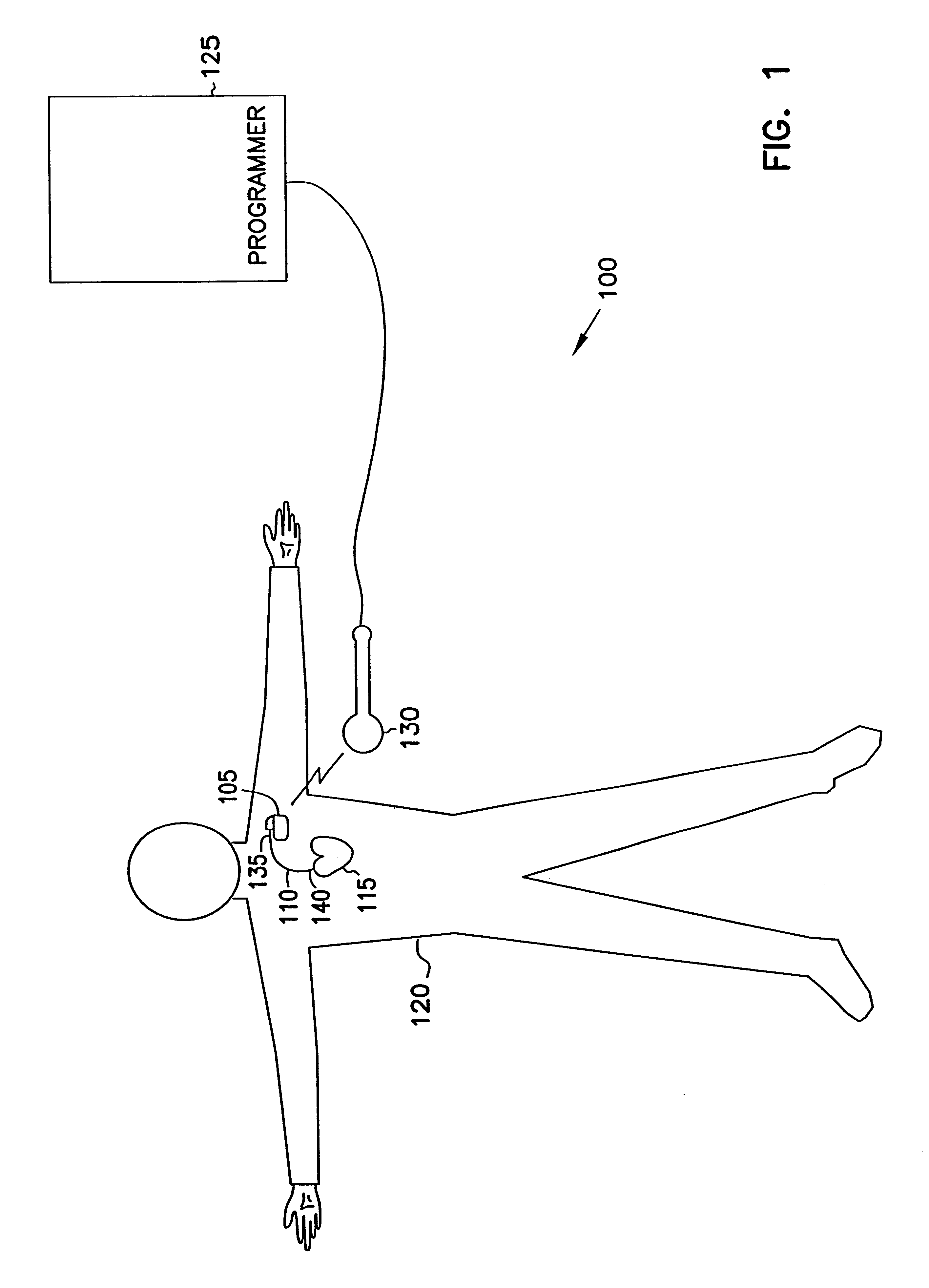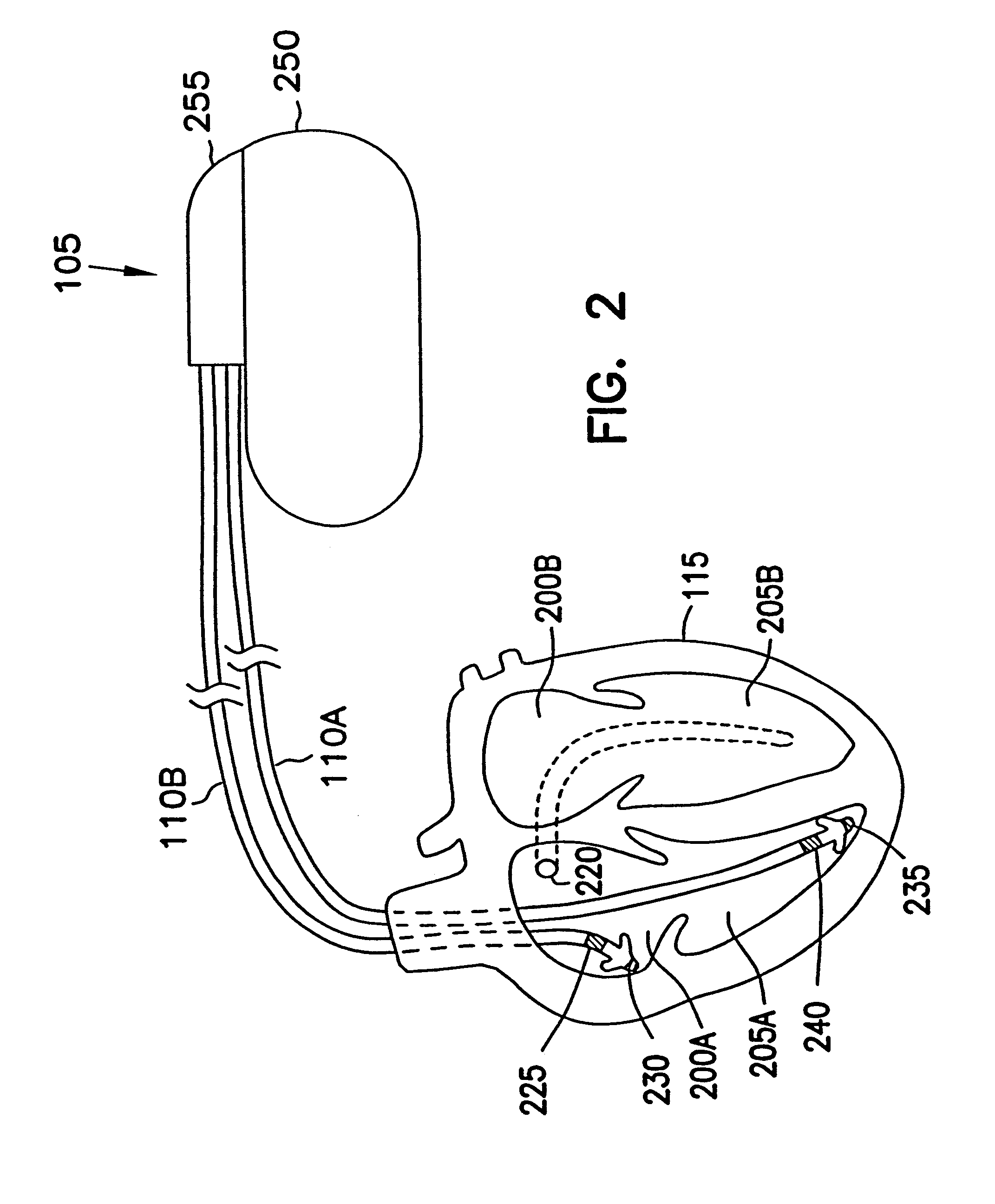Cardiac rhythm management system promoting atrial pacing
a technology of atrial tachyarrhythmia and management system, which is applied in the direction of therapy, heart stimulators, heart defibrillators, etc., can solve the problems of reducing achieves the reduction of the likelihood of the occurrence of an atrial tachyarrhythmia, the effect of promoting atrial tachyarrhythmia and promoting atrial
- Summary
- Abstract
- Description
- Claims
- Application Information
AI Technical Summary
Benefits of technology
Problems solved by technology
Method used
Image
Examples
example 1
FILTER EXAMPLE 1
In general terms, for one embodiment, device 105 obtains A--A intervals between successive sensed or evoked atrial beats. Device 105 computes a new first indicated pacing interval based at least in part on the duration of the most recent A--A interval and a previous value of the first indicated pacing interval. Device 105 provides atrial pacing therapy delivered at a rate corresponding to the inverse of the duration of the first indicated pacing interval.
FIG. 6 is a signal flow diagram illustrating generally, by way of example, but not by way of limitation, one embodiment of operating filter 515. Upon the occurrence of a sensed or evoked atrial beat, timer 510 provides filter 515 with the duration of the A--A interval concluded by that beat, which is referred to as the most recent A--A interval (AA.sub.n). Filter 515 also receives the previous value of the first indicated pacing interval (T.sub.n-1) stored in register 520. The most recent A--A interval AA.sub.n and t...
example 2
CONTROLLER EXAMPLE 2
FIG. 9 is a schematic diagram illustrating generally, by way of example, but not by way of limitation, another conceptualization of portions of controller 325, with certain differences from FIG. 5 more particularly described below. In FIG. 9, controller 325 receives from sensor 330 a signal including information from which a physiologically desired heart rate (e.g., based on the patient's activity, respiration, or any other suitable indicator of metabolic need) can be derived. The sensor signal is digitized by an A / D converter 900. The digitized signal is processed by a sensor rate module 905, which computes a desired heart rate that is expressed in terms of a second indicated pacing interval stored in register 910. The second indicated pacing interval is also referred to as a sensor-indicated pacing interval, or if expressed in terms of rate, a sensor-indicated pacing rate.
Pacing control module 505 delivers a control signal, which directs atrial therapy circuit ...
example 3
FILTER EXAMPLE 3
In one embodiment, filter 515 includes variable coefficients such as, for example, coefficients that are a function of heart rate (or its corresponding time interval). In one example, operation of the filter 515 is described by T.sub.n =a.multidot.w.multidot.AA.sub.n +(1-w).multidot.T.sub.n-1, if AA.sub.n is concluded by an intrinsic beat, otherwise is described by T.sub.n =b.multidot.w.multidot.AA.sub.n +(1-w).multidot.T.sub.n-1, if AA.sub.n is concluded by a paced beat, where at least one of a and b are linear, piecewise linear, or nonlinear functions of one or more previous A--A intervals such as, for example, the most recent A--A interval, AA.sub.n.
FIG. 12 is a graph illustrating generally, by way of example, but not by way of limitation, one embodiment of using at least one of coefficients a and b as a function of one or more previous A--A intervals such as, for example, the most recent A--A interval, AA.sub.n. In one such example, a is less than 1.0 when AA.sub...
PUM
 Login to View More
Login to View More Abstract
Description
Claims
Application Information
 Login to View More
Login to View More - R&D
- Intellectual Property
- Life Sciences
- Materials
- Tech Scout
- Unparalleled Data Quality
- Higher Quality Content
- 60% Fewer Hallucinations
Browse by: Latest US Patents, China's latest patents, Technical Efficacy Thesaurus, Application Domain, Technology Topic, Popular Technical Reports.
© 2025 PatSnap. All rights reserved.Legal|Privacy policy|Modern Slavery Act Transparency Statement|Sitemap|About US| Contact US: help@patsnap.com



